By Sylvester Asoya
Yemisi Shyllon loves art. The fascinating thing about this love affair which began in his teenage years as a junior secondary school student is that after nearly 50 years, the love is still waxing strong. In fact, art is his life!
Shyllon’s early curiosity and inherent ability to draw actually reinforced his interest and he drew all kinds of images up till form three. However, when it was time to go to the university, Shyllon disappointed art. He chose engineering, yet his career choice did not diminish his zest for art. While in the university, he was relentless in his love and exuberance for art and he did not allow science and engineering to slow him down.
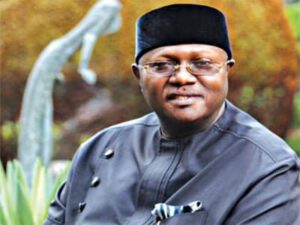
During his undergraduate days, this love affair was again reignited in the school where he used to read during the holidays. He saw art and artists at very close quarters and resolved to make them a part of his life. According to him, he was fascinated by two things: the artistic works from the school’s department of creative arts and the appeal of art to all the senses. So, in no time, he started collecting works, this began in his second year, 1974/75 session at the University of Ibadan. Today, Shyllon is still collecting art works. He has also achieved national and continental pre-eminence by virtue of his unalloyed commitment and contributions to art.
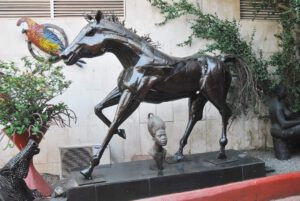
In 2016, he was declared Africa’s biggest collector. The same year, he also ranked among the top 100 art collectors in the world. Until one visits the breath-taking gallery and home of this unusual collector in Lagos, it will be difficult to fully appreciate Shyllon, his interest in art and why he is so highly rated in the art world. The gallery which has works in different art media, hosts both old and contemporary works of Nigerian artists and their counterparts in other parts of the world. Inside his outer compound, there are also birds of all kinds, including peacocks and ducks, fruit trees, a playground and beautiful flowers. Every day, his home and gallery attract visitors from far and near seeking natural ambiance, knowledge, pleasure, excitement and the peace that art brings. In Nigeria and other parts of Africa, for instance, Shyllon has received numerous awards in recognition of his contributions to art and culture. But of all the awards, two stand out. The first one is from the County of the British Parliament in the United Kingdom, while the second is the CNN recognition of 2016.
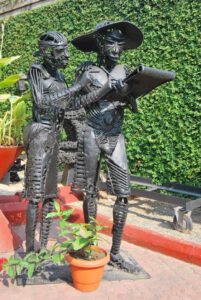
“I must confess, I never knew my influence and importance extended that far until I received those awards,” he revealed in an interview with alice.
But like most lovers of art, Shyllon has his favourite artists and works. He loves two remarkable artists; Leonardo da Vince, the Italian painter and creator of Mona Lisa, the most famous portrait ever made, and Michelangelo, another well-known Italian Renaissance sculptor and poet from Florence. He is passionate about the two Italians because according to him, “these two artists were great men that underwent positive rivalry within themselves for the benefit of humanity.”
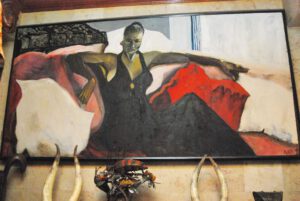
But Shyllon is not just a stock-still art collector who waits, he also travels and sees.
“I have visited where Leonardo da Vinci last lived on earth. He was not just an architect and engineer; he actually drew the first image of what an airplane should look like. He was indeed, a man of many parts. His last abode is Le Chateau du Luce where miniatures of his inventions are located. I have also been to Chapel of Saint-Hubert, Ambrose. All these are in Lower Valley Region of France. For the great Michelangelo, I also visited Galleria dell’Accademia in Florence where the statue of David, one of the world’s most famous statues, is located; the Vatican Sistine Chapel; the Cathedral in Rome where he has the statue of the Biblical Moses, Te Pieter at the Vatican and other sites of interests,” he said.
For Nigeria, a country that still faces challenges of nation-building, Shyllon believes art and literature has a role to play in redirecting the country’s affairs. Therefore, if literature is truly life as widely believed, then its components like prose, satire, drama and poetry are ready instruments and tools for growth and development.
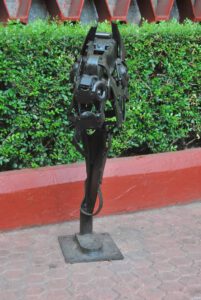
According to him, “all these parts of literature can be used to highlight the needs of a country towards its development and also criticize and appraise political evolution. Literature can also propagate and spotlight a nation’s beauty, essence and richness of history with a view to identifying those national experiences of the past to better guide and direct the present and the future. Art, on the hand, complements literature. While literature appeals to the senses via transmission of eye and other senses, visual art does more than that. Art satisfies man’s desire to document his past, his present and his future through all the sensory organs, including smell.”
For nearly 50 years now, Shyllon has been acting different roles and at different times in Nigeria’s art and culture sector. For him, it is still morning; he wants to push the boundaries until the very end. He is also willing to give more to creativity because of his love and belief in art and what artists can do with their imagination. At the moment, over 30 people have benefitted locally and internationally from his artists-in-residence programme which is still running.
Shyllon has also vowed to continue capturing and documenting Nigeria’s fast disappearing festivals, this is in addition to his role in drawing attention to the declining appreciation of indigenous cultures in Nigeria.
In his exquisite collections are cultural and historical objects like patinated bronze sculptures, vintage wood works, metal, bronze, recycled materials from rubber, kitchen utensils, metals, cables and auto parts. On display at his breath-taking scenery are works like Ekpe Masquerade used by early Christian missionaries to covert the Efiks of Cross River; Argungu Fisherman, a giant bronze work; Mother and Child (White Stone) and the largest bronze Eyo in Nigeria.
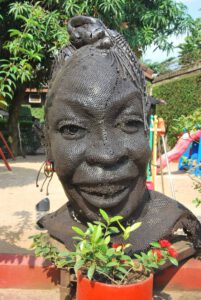
In his repertoire also are the bronze work of Emotan, the influential market woman from Benin kingdom; Benin ivory masks; massive bronze horses; a village scene and Ekombi Dancer, a traditional dance of the Efiks that represents happiness and peace. At the entrance to his house are other great works like an armed soldier on guard, a metal tiger and countless other works on display. The gallery is indeed a place to visit.
In a way, the facility says a lot about this humorous and uncommon collector who holds degrees in Engineering, Law and Business Administration. He insists that knowledge and exposure determine wisdom, so he has promised to keep travelling, learning and collecting.
*This article was first published in alice, the in-flight magazine of Air Peace.